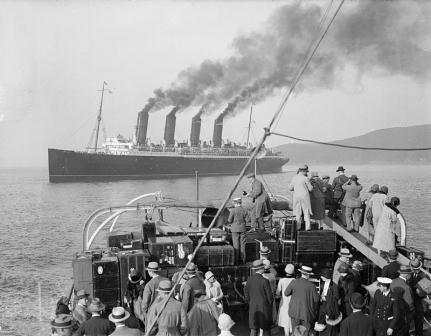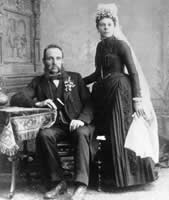Making A Life In America by Linda Derrick
Second in a series
Imagine being newlyweds and leaving your homeland to travel across the ocean to start a new life never to return again. In 1851, that is just what George Mayer and his wife Juliana did. They are married in February of that year; and shortly thereafter, they leave their home in Germany and sail on a ship called the "Southampton" bound for America.
George Mayer and his wife Juliana did. They are married in February of that year; and shortly thereafter, they leave their home in Germany and sail on a ship called the "Southampton" bound for America.
It can't be easy to leave their families behind. They are married only two months when they land in New York. For several more weeks, they continue their travels to get to Wisconsin where they settle in Washington County. We assume they chose Wisconsin because George's sister, Katherina (Mayer) Messer, had settled in this area with her husband and children just five years earlier. George and Juliana probably stay with Katherina's family for the first year they are here. George is a farmer by trade. And, like many German immigrants, he is probably drawn to southeastern Wisconsin. The land is good for farming, and the rolling countryside is similar to the land they left behind.
In October of their first year here, Juliana gives birth to a son. Unfortunately, he only lived two days. We don't know the circumstances surrounding his death; but regardless, that first year is most likely a challenging one for these newlyweds.
By the end of 1852, they are able to purchase 40 acres in the Town of Polk. Now they can build a home of their own and begin to farm their own land. Another year goes by, and they welcome their second son. However, again, tragedy strikes when this child dies after one month. Over the next 20 years, Juliana gives birth to 11 more children. Only five of them live past childhood.
In the mid-1800s, it isn't uncommon for one in every five children to die before reaching adulthood. But, for George and Juliana, the survival rate of their children is far worse. But, they don't give up. They work hard farming their land, and they continue to prosper in their new homeland.
In 1874, George's nephew, Andrew Messer, is killed in a horse accid ent leaving his young family with a farm, a saw mill and a grist mill to run. Andrew's widow can't manage all of this; and George and Juliana purchase the property including the mills, the house and the farm. This is the property that today is the Richfield Historical Park. At the time they purchase this property, George is 52 years old. His oldest living son, Charles (better known as C. W.), is 19 years old. George and C. W. take over operation of the two mills.
ent leaving his young family with a farm, a saw mill and a grist mill to run. Andrew's widow can't manage all of this; and George and Juliana purchase the property including the mills, the house and the farm. This is the property that today is the Richfield Historical Park. At the time they purchase this property, George is 52 years old. His oldest living son, Charles (better known as C. W.), is 19 years old. George and C. W. take over operation of the two mills.
We don't think that George and Juliana ever live in the mill house. They probably continue to live on their homestead in the Town of Polk. C. W. may have lived in the house by himself for a while. As the mill operator, it is convenient to live there since it is a short walk across the yards to the mills.
A few years go by and C. W. marries Marianna Kurtz. By this time, his f ather George is close to 60 years old, and C. W. purchases the property and the mill businesses from his parents, George and Juliana. C. W. is sole operator of the mills now, and the businesses are providing needed goods and services to the immigrants who continue to arrive in the area. The saw mill produces lumber for building as more and more farms are established. A growing farming community depends on the grist mill to process the grains.
ather George is close to 60 years old, and C. W. purchases the property and the mill businesses from his parents, George and Juliana. C. W. is sole operator of the mills now, and the businesses are providing needed goods and services to the immigrants who continue to arrive in the area. The saw mill produces lumber for building as more and more farms are established. A growing farming community depends on the grist mill to process the grains.
Throughout the late 1800s, C. W. and Marianna's family is growing. Their first child is a daughter, followed by five sons and finally another daughter. C. W. and Marianna are enjoying a busy life raising their family in the mill house, operating the mills and managing a working farm. The mills continue to prosper.
Hope you enjoyed this story
Enjoy our other stories

